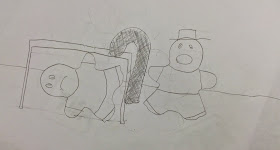My students aren't required to know much (according to the Virginia Standards of Learning) about the presidency of John Adams. In fact, they only have to know that a two-party system emerged when he was president. It's one of those blah facts that one could quickly mention, in order to race to more exciting things like the Louisiana Purchase and the War of 1812. But, in order for students to truly understand two-party politics, I feel that laying a strong foundation is important. So, we spent some time learning about the issues that divided the nation in the 1790s. And, what came about, was pretty awesome.
Learning the Material:
To merely say that the two-party system emerged on John Adams' watch would ignore the early beginnings of Hamiltonian and Jeffersonian arguments during Washington's administration. Because of time constraints, we (my teammates and I) gave the students a 2-page single-spaced document on the origins of the two-party system, with a focus on Hamilton and Jefferson's viewpoints on various issues. After reading the document together, having students highlight their different viewpoints, elaborating on certain issues, and answering student questions, we had students work in small groups to complete the chart below.
Federalists
(Alexander Hamilton, John
Adams, wealthy merchants, elite
landowners, industrialists)
|
The issues
|
Democratic-Republicans
(Thomas Jefferson, James
Madison, ‘the common man’, rural americans)
|
|
National Bank
|
|
|
Protective Tariffs
|
|
|
Paying off the Revolutionary
War
|
|
|
Excise Tax on Whiskey
|
|
|
Foreign Policy
|
|
|
Strength of the Central Government
|
|
|
Alien and Sedition Acts
|
|
|
Rights of States to Nullify
|
|
|
Interpretation of the
Constitution
|
|
As they were filling it out, we could also highlight things that were so important in the lead up to the Civil War--such as the northern and southern views on tariffs, the strength of the national government, rights of the states, and the interpretations of the Constitution.
The sixth graders also quickly form their own opinions about taxing whiskey to control drinking habits and raise revenue. They grow angry at learning of the Alien and Sedition Acts only a week after we learned about the First Amendment. After completing this chart, it is my hope that students have a good grasp of the issues that faced the nation during the 1790s and in the election of 1800.
Forming Sides:
Following the completion of the chart, we divided students into two groups. One group, the Federalists, were asked to work together for John Adams' reelection bid in 1800. The second group, the Democratic-Republicans worked to get Thomas Jefferson elected in 1800. Students had been informed of the previous friendship of these two men--Jefferson and Adams--and now are aware of the stark differences that divided them.
Before class, I
arranged the desks into two large groups, representing the two political parties. Within those groups, students work in groups of 3-4 to create different aspects of their campaign.
Running Campaigns:
We asked the two political parties to record a campaign commercial in support of their candidate, create campaign slogans and flyers, and also to write a campaign speech.
Of course, before we did this, we showed students some examples of commercials from previous presidential elections. There were lots to choose from at the
Living Room Candidate website. We chose several ads to show students how they can look very different and still be powerful. We selected ads that included musical jingles, optimistic tones, and negative attacks.
Students created flyers that were hung throughout the school. "Vote for Johnny, not for Tommy" and "Jefferson, Man of the People" were a few of the slogans seen by the school community in the lead up to our election.
Creating these flyers, commercials, and speeches required students to really know the content. They needed to highlight the best of their candidates and downplay the worst. John Adams wasn't going to win by focusing on the Alien and Sedition Acts and Thomas Jefferson probably didn't want to talk about the bloodshed in the French Revolution (that he supported).
The Election of 1800:
Students were challenged to run effective campaigns. One student from each group represented the candidates and gave a speech in the auditorium to several classes, attempting to earn their votes. Next, we showed students their commercials. Then, the students voted using an online ballot (I even got a write-in vote from one student). After voting, each student received an "I voted" sticker that was generously donated to us for our lesson.
Results:
Kids were engaged. They were challenged. They were eating up the content. They were eager to ask questions about the issues. They were collaborating on campaigns. They were taking perspectives they didn't necessarily agree with and formulating strong arguments. They felt the frustrations of sharing some views with both parties, and therefore, disagreeing on some issues with each party, and having to choose one of them anyways. They were creative with their videos. They were laughing when we watched the ads. They worked hard.
And, yeah, we had a good time.









